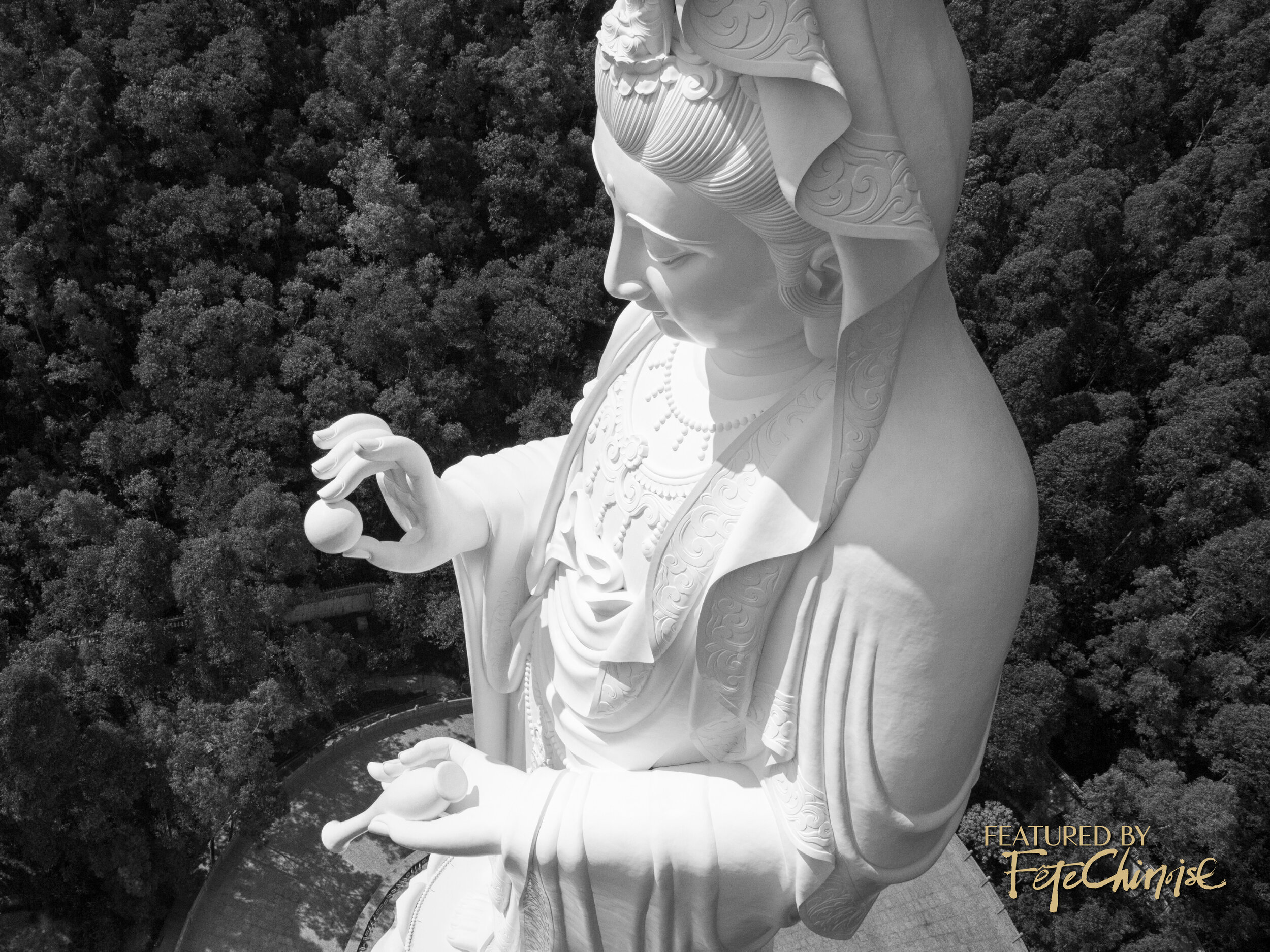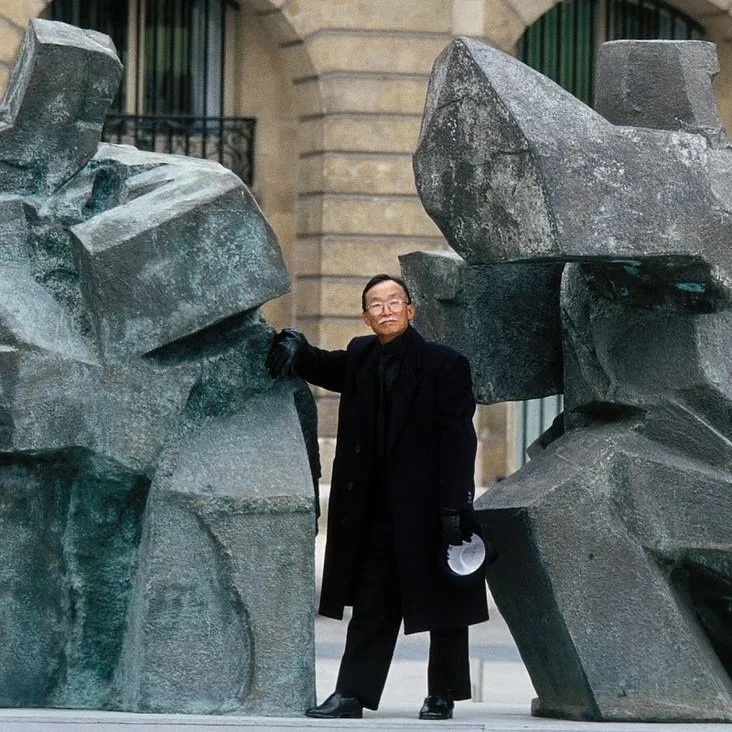Journey to Calm: Sanctuary in the Heart of a Metropolis 平靜之旅:城市中的寺院
Written by Fête Chinoise Team
Content & Photography provided by Tsz Shan Monastery
“A bell rings and a hush falls over the faithful.”
Thankfully, this impressive monastery, home to monks and nuns who live there, welcomes visitors. Engaging the local and global community, the monastery delivers diverse approaches towards anxiety, joy, love, and death, through meditative practices and rituals in its open space for those who are seeking. Below we highlight six rituals performed at Tsz Shan, where you can take an imagined journey to experience them ahead of travelling to the coveted sanctuary.
“春有百花秋有月,夏有涼風冬有雪,若無閒事掛心頭,便是人間好時節”
心隨境轉。人的心往往隨著外在的環境而轉變,難以安定下來,稍作歇息。在都市的忙碌生活中,我們總是被種種五光十色的環境因素牽動著,看似精彩,漸漸地卻形成了一種沒有辦法慢下來的生活壓力。外在的壓力越大,內在的心力越少。脆弱的心讓人感到生活失去動力,容易抱怨,無法跳出框框去思考問題,甚至破壞重要的人際關係,影響到家庭、職場及社會的和諧。長期積累下來的壓力更會引發難以擺脫的疲累感,以及反映在身體上各式各樣難以根治的身心緊張和不適,慢慢演變成一種身心分離感,難以好好地照顧自身的需要。
《慈山寺》位於香港新界的八仙嶺,佔地約五十萬平方呎,由李嘉誠基金會興建,用了超過十年時間建成,它的建設和日常經營成本超過17億港元(約2.75億加元)。建築設計關注綠化,碧綠的山丘包圍著它壯麗的唐代建築和宏大的觀音菩薩聖像,力求與周邊環境和諧共生,與自然景色融為一體,整體設計返璞歸真,以 「 境 」 說 法 ,並兼具傳統特色與現代化功能。雖然慈山寺是出家人的宿舍,但慈山寺也非常歡迎大眾來訪。李嘉誠先生冀以慈山寺實踐佛教核心理念: 淨(Clarity)‧慈(Compassion)‧行 (Action),希望每一位到來體驗這幾種修持法門的朋友都可以透過這裡的體驗和發現,重拾在生活中培養安定心神的好習慣,從而提升心靈的正能量,積極地回應身心需要。希望能夠提供給塵世的人一些面對生活中喜怒哀樂的方法,給予在尋求生命意義的人一個開放空間去沉思和參與不同的佛教修行儀式。我們以下為讀者介紹六項慈山寺提供的修行儀式,同時也期待著讀者自己用想像力去啟程到一個更平靜的心境。
ritual (1): Water Offering
Monastics or visitors carry water, which represents clarity and calmness, in a shallow elliptical wooden bowl and weave through the Tsz Shan Monastery. This is known as the water-offering practice.
The walk is a slow-paced procession beginning from Brilliance Pond inside the Grand Courtyard. You then walk around the Universal Gate Hall and tread on Compassion Path to reach the Thousand Wishes Pond, right next to the grand white Guan Yin statue. This is considered the end of the walk. You can continue to circle slowly around the statue several times with a mind focused on the Goddess or other bodhisattvas and buddhas. This experience brings you to a state of clarity and calmness with each careful and contemplated step.
修行儀式(一):供水
出家人或大眾都可以參與供水儀式。水,代表清淨的心,乃生命之源,卻常常給白白浪費。供水的修持,以水喻心,同時提醒我們最珍貴的,往往是最基本的,早已垂手可得,近在眼前。因此,在供水的時候,我們不再向外追求,於當下回歸初心,照顧自己真正的需要。
每一位都會托著水砵,然後在慈山寺裡步行,這就是供水儀式。你可以從大院中的洛迦池開始步行,然後繞著普門到慈悲道再拐彎到千處應。在這個時候,你應該看得見白色的觀音聖像。在這裡,儀式就完畢了。可是,你也可以繼續圍著聖像行走幾個圈,心裡想著觀音菩薩或其他菩薩。這個供水儀式可以給你清晰的頭腦和平靜的內心,深思熟慮的每一步都能夠慢慢地帶你進入不同的境界。
ritual (2): Sitting Meditation
Visitors can participate in a restful and restorative practice of sitting meditation. The length of the duration is completely dependent on the person. It will benefit those who seek to develop their minds, granting access to a quiet awareness.
There are many places to put this ritual to practice. You can choose to sit inside the inner halls or sit outside under the shade of the trees. Find a suitable posture — some prefer sitting cross-legged with a cushion while others prefer to sit on a chair. More importantly is finding stability in your posture. Then calm your mind by finding an object or matter to focus on, such as your breathing. Feel your body’s movements as you breathe in and out. After choosing the right place and position, you may concentrate on other thoughts and develop mindfulness. This meditation hopes to follow you throughout the day and be incorporated into your everyday life in the city.
儀式(二):靜坐冥想
到慈山寺的參觀者也可以參與靜坐冥想的儀式。冥想時間的長短由個人所需要而定。這個儀式有利於那些想要探索思想的人。
慈山寺有很多地方可以靜坐冥想。你可選擇在院內的大廳靜坐,也可以在外面的樹蔭下靜坐。選了地方坐下來後,就要找到一個合適的穩定坐姿。有些人喜歡用坐墊交叉坐,而有些人卻喜歡坐在椅子上。最重要的是那個坐姿能夠讓你毫無雜念地安靜下來。你可以留意自己的呼吸,隨著一呼一吸,感覺全身的收放。從留意呼吸可以慢慢轉到思考其他事與物,從而覺悟。這個冥想儀式希望在日常生活可以幫助你維持一個安靜的心。
ritual (3): Zen Calligraphy
Monks and visitors can join in the process of recopying the scriptures. Seen as a form of devotion for monks and meditation for laymen, one can find peace through writing with the right mind. Buddhists believe that this act of recopying is a good deed and benefits not only oneself but also others.
The Heart Sutra will be laid before you. The text in Chinese is 260 characters long — an abridged version of the original. You may copy as much as you can, but it must be done mindfully. You will join the many others before you and around you who have copied out the wisdom embedded in this canonical text.
儀式(三):抄經
出家人和參觀者也可以一起抄佛經。僧人視此為一種放下自我的修行。一般的人也可以當作是一種專注當下的鍛鍊。只要用一顆無雜念的心去抄經,讓人不安的事情會慢慢離你而去。佛教徒認為抄經是功德的行為;不僅為自己積德,也為眾生積福。
方法十分簡單,把心經放在檯面,全文約260個字,抄經時間、遍數是次要,重點是集中精神以恭敬的心把一字一句抄寫下來。經文中的哲理可以靜心修身,幫助確立生命的意義。
ritual (4): Tea Meditation
Tea is used to calm the mind and as an object of concentration. Discovered in China over five millennia ago, having tea became a common pastime of intellectuals in the Tang dynasty and spread throughout East Asia. This ritual of tea at Tsz Shan brings similar sentiments of relaxation, clarity, and warmth.
You will be seated and a cup of tea is presented to you. The ceremony begins with the ding of a small bell. You can be guided by someone or choose to meditate on your own. You may concentrate on each individual element of drinking tea: from the texture, weight, and warmth of the cup, the smell and taste of the tea, to the feeling as you drink the tea itself. You will learn to appreciate the simple experience and find value in the seemingly mundane.
儀式(四):茶禪
品茶有助提升專注力和覺察力。禪的意境不能靠語言文字解釋,只能從親身經驗中感悟。早在唐代,文人已經有品茶的習慣,常以「喫茶去」三個字提醒大家,切勿玩文字遊戲,要把修持落實於日常生活,直接體驗禪味。後來,茶道傳遍東亞州。慈山寺也希望可以把品茶承傳下去,讓參觀者感受到它讓人領悟真諦的能力。
坐下來後,一杯茶會奉上你面前。聽到輕輕的叮噹鐘聲後,儀式就開始。可能會有人指導,也可能是由你自己去探索這個過程。品茶的時候,留意茶香、茶色、茶溫、茶味和泡茶的聲音去感受當下,體會感官和心的互動變化。簡單就是福,儀式完了之後,你或會開始發現平凡中的美好,欣賞簡單生活的價值。
ritual (5): Walking Meditation
The practice of walking meditation could not be simpler: walk. But the difference between walking meditation and ordinary walking is walking with full, mindful awareness. Experience the present moment without trying to or worrying about where to go or what to achieve.
Slow down your movements and allow your thoughts to slow down. It is normal to struggle with this as you begin to notice the busyness of your mind. This focus on walking should settle your mind. You will begin to focus on the weight shifting of your body, the movement of muscles and legs, and the your feet. This calmer speed of walking and mindfulness will become natural and unforced as time goes on. This awareness of the body brings clarity to your feelings, the surroundings, and others.
儀式(五):行禪/步行冥想
行禪又名經行、步行冥想,舊云「行道」。禪是很簡單的身心練習。專注每一個步伐就是步行冥想與普通步行之間的區別,感受當下的環境,受攝散亂的心和塵世的慾望。
放慢腳步,把思念也放下,讓身心融合在一起。一開始的時候找到內外和諧可能很難,但是慢慢你會留意到不同的雜念,然後你的身體跟土地的互動,你會漸漸發現你的腳步跟你的思想開始有了規律。心息相依,你會聆聽到你自己的內心和身邊的事與物。
ritual (6): Birdwatching
Birdwatching trains the mind. Some watch with the naked eye, some use binoculars, and others see by listening for sounds from the birds. Birds have a central place in Buddhist culture: the ceremonial freeing of birds is seen as good karma and respectful.
With almost 70 types of birds that frequent the area around Tsz Shan, you can learn about the impermanence of life through this ritual. As you wait, the serendipity of a bird’s appearance helps train one’s patience and understanding. You may not always see a bird that you seek, which teaches you more about the fleeting nature of many things in life.
儀式(六):觀鳥
觀鳥可以訓練身心。你可以用肉眼或用望遠鏡觀看,有些人更會靠著鳥聲來觀鳥。佛教文化裡,鳥類是常常被提及的動物,而放生禽鳥這個活動還被視為行善積德之事。
通過這個觀鳥儀式,你可以觀賞到慈山寺周圍近70種鳥類,而從中了解生命的無常。當你等待著一隻鳥,你其實在訓練耐心。當你遇不到你所等待的一隻鳥,你會學習到生命中有很多不能強求的人和事。這些鳥兒雖小,可是牠們可以幫助你踏上一輩子靜心之旅。
These rituals are just some examples of the lessons of monastic life offered at Tsz Shan Monastery. It is their hope that these practices can be integrated into the everyday, whether you find yourself in a bustling urban city such as Hong Kong, or wherever you may be. Join the journey to a more meditative life and visit the grounds at the Eight Peaks of Immortals if you have the opportunity!
這些儀式只是慈山寺提供的修行生活的一些例子。無論你是在香港這樣繁忙的城市,或身在其他地方,都希望這些儀式能夠融入日常生活中。如果有興趣參加修行旅程,歡迎參觀香港八仙嶺上的慈山寺!




















